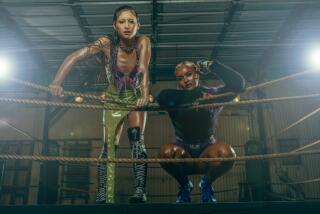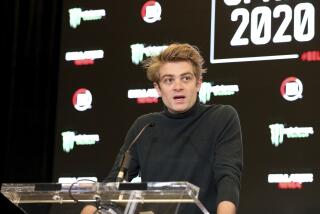With ‘Toonder and Lightning,’ Ingemar Johansson weathered Floyd Patterson bouts
- Share via
There was a time, long past, when the heavyweight boxing champion of the world was among the more famous and celebrated people on Earth.
Even if he came out of nowhere, or Sweden, as was the case with “Toonder and Lightning” Ingemar Johansson, he became a household name. Now, we don’t know who they are, much less where they have households.
When Johansson died in Sweden last weekend at 76, apparently another victim of boxing’s inevitable ravishes of dementia, it stirred the memories of the fight trilogy that made him famous. Or, more specifically to Johansson, his moment when Toonder became Lightning.
That took place in the first of his three fights with then-heavyweight champion Floyd Patterson. It was June 26, 1959, in Yankee Stadium, with Patterson a shocking 5-1 favorite -- in boxing that’s a sell-your-house-and-find-a-bookie spread. The underdog has to be a cadaver.
Johansson was the European champion, but a reputed soft trainer who was more accessible to the media in after-hour nightclubs with an attractive female on his arm than in boxing gyms. He had gotten his shot at the celebrated Patterson by knocking out the previously indestructible Eddie Machen in the first round of a fight in Sweden. The smart money called that a hometown fluke and saw Patterson’s defense of his title as another yawner until a real challenger came along.
Still, any heavyweight title fight was a huge deal back then.
“Those were the days of closed-circuit TV for the fights,” said John Hall, former Times sports columnist. “I watched at Hollywood Legion Stadium. I’d say there were 5,000 people there.”
The first two rounds were routine. But in the third, Johansson threw a big left hook that Patterson blocked, but left himself open in the process. In that opening, Johansson threw the right hand he had lovingly labeled “Toonder and Lightning” and a shocked boxing world watched and listened as Patterson hit the canvas. He got up, but Johansson chased him relentlessly, knocked him down six more times and finally was given the victory when referee Ruby Goldstein stopped the fight.
Unbelievably, there was still nearly a minute left in the round. If the fight had taken place today and the referee had allowed seven knockdowns in 2:03, they would have taken the referee off in handcuffs.
They fought again just six days shy of one year later, this time in New York’s Polo Grounds. In the fifth round, Patterson caught Johansson with a leaping left hook that put the Swede down and so out that he gave everybody watching, including Patterson, a scare by twitching while unconscious on his back and not regaining consciousness for several minutes.
Many of those in boxing were surprised that there was a third fight.
“Maybe with better management, he wouldn’t have had to go through that again,” said Don Fraser, longtime Los Angeles fight promoter. “I could never figure out why his handlers took that third fight.”
It was March 13, 1961, in Miami Beach, and while it wasn’t as lopsided as many expected -- Johansson actually knocked Patterson down twice -- Patterson knocked Johansson out in the sixth.
Interestingly, before that match, Johansson had sought a younger and fast fighter as a sparring partner, and the ideal place to find that was at Angelo Dundee’s gym in Miami.
“He asked and I said I had this young guy,” Dundee said. “I was a little worried about putting this tall, skinny kid in there with Ingo. But the kid was always after me to let him spar and let him do this and that. So I took a chance and they went about three rounds and Ingo still hasn’t hit my kid.”
Johansson fought only four more times after that third Patterson fight, retired with a 26-2 record and probably made a good decision because, had he stayed around a bit longer, he might have had to face, in a real fight, that same tall, skinny kid named Cassius Clay.
In retirement, Johansson lived what local sports promoter Al Franken termed “an idyllic life.”
Johansson stayed close to Patterson -- they made a point to visit each other at least once a year -- and he even took up distance running. That’s what prompted Franken to begin a friendship.
“I heard that he and Patterson had run a marathon together,” Franken recalled, “and years later, I remembered that when I had this terrible promotion I had to handle. The client was Foot Locker, but the idea they had was awful. They wanted me to promote an 8K race in Griffith Park and it was a partners race -- you and your wife, brother and sister, father and son, etc.
“So I got Ingo and Patterson to come to L.A. -- partners, get it? -- and they were great. In those days, you didn’t have to pay an arm and a leg to get an athlete to appear, and so the client ended up loving it. They had dinner with two former heavyweight champions, and these guys who everybody had forgotten were getting paid to do something.”
Franken said that Patterson finished the 8K in such good shape that he placed high in his age division. Johansson was a different story.
“This was maybe 20 years ago,” Franken said, “and by then, Ingo weighed about 300 pounds. But he finished the race. It took him forever, but he finished.”
Johansson weighed 196, 194 3/4 and 206 1/2 for his three fights with Patterson.
“We had a round of golf, and he hit the ball a ton,” Franken said, “but always about 150 yards off line. He laughed and joked, and afterward we had a few drinks, and I’m sure, dinner. We know he didn’t pass up food.”
Franken said he did a few other events with Johansson and they stayed friends, even when they didn’t see each other for long periods of time.
Patterson also was struck by dementia late in life, and he died in 2006. Franken said that he knew that Johansson was ill and feared the worst.
About seven or eight years ago, he said, “the Christmas cards stopped coming.”
--
More to Read
Go beyond the scoreboard
Get the latest on L.A.'s teams in the daily Sports Report newsletter.
You may occasionally receive promotional content from the Los Angeles Times.











